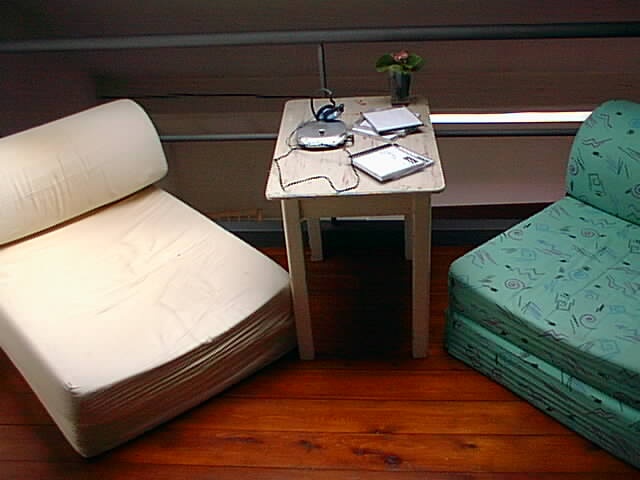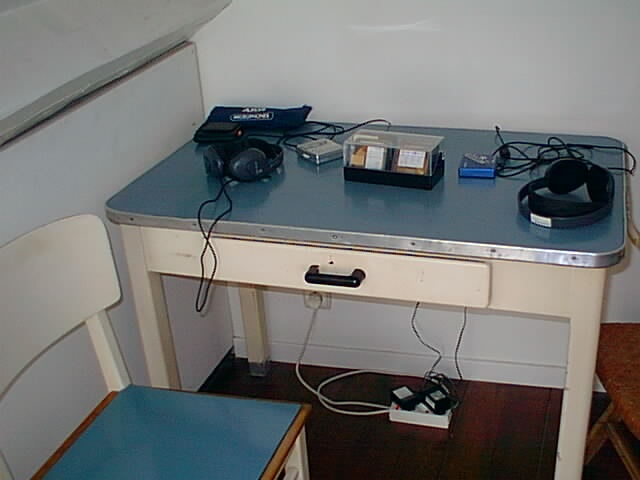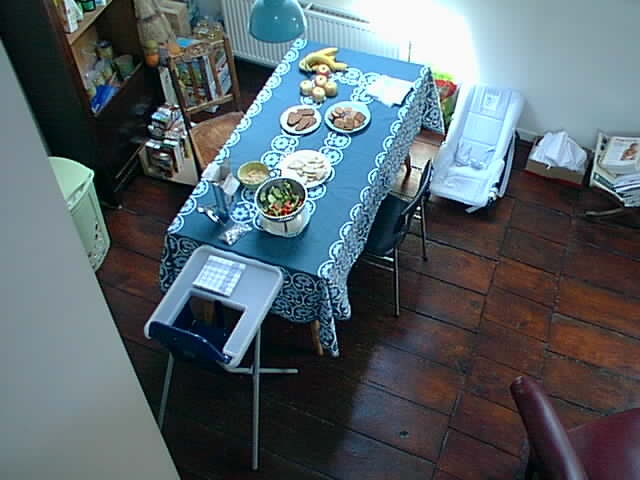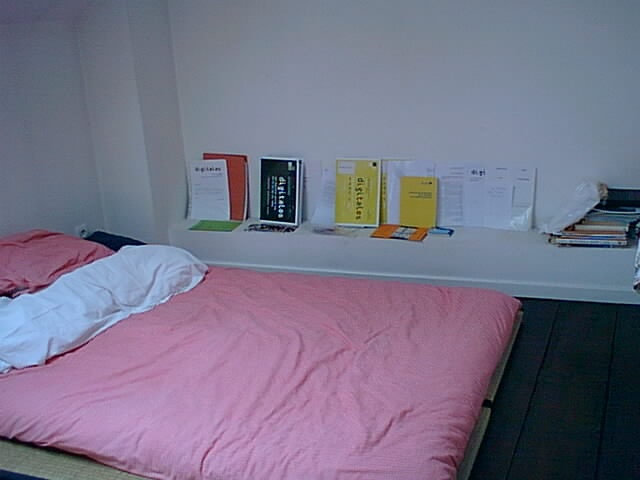This is a little text I made for people who attended the open house to introduce the play of archiving. As soon as I scan some of the booklets that people used I will put them online too.
Read More
-
Pages
-
Categories
-
Archives
This is a little text I made for people who attended the open house to introduce the play of archiving. As soon as I scan some of the booklets that people used I will put them online too.
Read More
these are some images of the media stations at the archiving open house…

the audio cd station

the minidisk station

the snack station

the text station

the video station
more images and text are coming soon…
The Archiving Open House (2004) is a prototype venue for archiving the physical traces from the Digitales Meeting Days by way of encounters between people (a process which I refer to as a play of archiving). The physical archives of the Digitales Meeting Days include minidisks, audiocassette tapes, CD’s, miniDV tapes, VHS tapes, floppy disks, and texts. Guests have been invited into my home to use media stations that I have set up there to access the material. Guest are invited to discuss their interest in an archive item with each other, and to record a brief indication of these discussions in booklets that I have prepared.
1. Find out what the topic of the publication is. I was asked by Constant to make a text following the seminar the Lining of Forgetting for a publication about VJ7.
2. Choose the material that you would like to work with. I decided to work with the discussion recorded on the second day of the seminar. This material was on minidisk, so I used a minidisk recorder and headphones to listen to it.
3. Find a format that suits your material. I made a scenario, which means that I transcribed the discussion and then selected parts of it to make into scenes. I introduced the scenario by writing a brief text about Constant, their archives, and the Lining of Forgetting seminar. Then I wrote a brief introduction to each of the ‘player’s the scenario. I used the Lotus Word Pro for this.
4. Ask someone to collaborate with you for the illustrations and layout. I asked Arnaud Dejeammes if he would do some illustrations based on both the scenario and on my research project. Arnaud used Microsoft Paint for the illustrations and Photoshop 6 for the layout.
5. Cover your finished text and illustrations with a creative commons license. We used a share-alike license, but you can choose your own at http://www.creativecommons.org
6. Give the finished text and illustrations to the designer of the publication. The VJ7 publication was designed by Harrison, so Arnaud and I worked with him to make sure that our text ( the font and the spacing) fit with the rest of the publication.
7. Wait for the publication to be printed.
8. When you receive copies of the printed publication, distribute them.
1. Ask people in advance. I asked De Geuzen, Anja Westerfrölke, and Nomeda and Gediminas Urbonas before they arrived in Brussels if they would agree to have a recorded discussion with me about archives.
2. Write your questions. Make them about what you want to know. Don’t make them too complicated because they might be confusing.
3. Record the interview. I used a minidisk recorder and a mic.
4. Transfer the interview from the minidisk to the computer. I did this with RCA cables and a mixing board hooked up to a computer. You could also use a firewire cable and hook it up directly to a computer. The software I used to capture the recordings was SoundForge 7.
5. Edit the interviews. The software I used to edit was SoundForge 7.
6. Diffuse the interviews. Just make sure that you check with the people you interviewed to be sure that they agree.
1. Do a little research. I was asked by Constant to be a respondent for the Lining of Forgetting, a two-day seminar about archiving that was organised as part of VJ7. This meant that I was supposed to lead a discussion with the invited guests. So the first thing I did was to find out about the guests. They were: De Geuzen, who are a group of women from the Netherlands; Anja Westerfrölke, an Austrian artist; Nomeda and Gediminas Urobonas, two Lithuanian artists; Jorge Blasco Gallardo, an artist from Spain; and Nathalie Trussart, a Doctoral candidate from Belgium. All of them were working with the idea of archives, though from very different standpoints.
2. Write your questions. Make them about what you want to know. Don’t make them too complicated because they might be confusing.
3. Go to the seminar. I took notes while people were speaking so that I could adapt my questions to the discussion.
4. Ask your questions. Listen to the answers.
5. After the seminar, write a report based on your notes. Give it to the seminar organisers ( I gave mine to Constant)
How to use a webblog as part of your research process:
1. Find a webblog space and software. I used MovableType software, because this is what they use at Constant and it was Constant who gave me the server space. However, you can find a lot of webblogs for free online.
2. Upload things as you research to it. You can upload text, and depending on the type of webblog, images and other files. I did this starting last June and I still continue right now. It is a nice way involve people and get feedback because people can leave comments about the things you put there. Plus, you can track your research when it comes time to make a dossier.
My sister and I made a quilt for my daughter for her first Christmas. A quilt is a type of blanket made from pieces of fabric sewn together. This quilt is a patchwork of different fabrics which were chosen by my sister. The quilt is called a rag quilt because it is sewn in such a way that all of the edges of the fabric pieces will fray with use and over time. The pattern is squares of fabric with alternating hearts and stars sewn on top. Each square of fabric is printed with a different pattern of images. Each square of fabric was chosen by my sister specifically for this quilt for my daughter. Some of the fabrics were chosen because the images in the pattern refer to Canadian culture: the hockey player, or ice skate images for example. Other fabrics were chosen because they are pieces cut from larger fabrics that my family uses – from clothing or the piece that matches a part of my nephews quilt, for example. The quilt is functional – it keeps my daughter warm and is also used as a play mat in our living room. The quilt was made collaboratively – my sister and I both took part in the process of making it. and this quilt is an archive: the patterns, the fabric, the quilt itself all bring together signs which represent our family, our culture, and our memories.
I see quilting as an example of women producing archives. Quilts are made by sewing pieces of fabric together in a specific pattern. The pattern is the only part of creating a quilt which is static. One may choose the type of fabric, the colour, the size of the pieces. Historically, quilting has served as a gathering place for women, for example the quilting bees where women came together to attach the finished quilt to a filling and backing.( old mist. 78). Quilts were also a useful object: they kept people warm when they sleep. At the same time, quilts were also a gathering together of signs to be related to memory, in a directly physical way: ‘personal, political and social meanings were sewn into these quilts in abstract forms by means of colour and symbolic composition. Quilt-makers evolved an abstract language to signify and communicate their joys and sorrows, their personal and social histories.’(parker and pollock, 77)
Quilts then have a dual purpose – they are functional, they are still part of a daily use, but they are also an object that is made with the intent to be related to memory. The quilt that my sister and I made keeps my daughter warm, shows symbols of her culture and represents to her the closeness, or intimacy of my sister and I because of its collaborative making.
I think that quilting represents a feminist possibility in creating a living archive. I say feminist because they come from a history of production by women and they often represent a collaborative activity which denotes a type of intimacy. They are a living archive because they are at once a useful object, but even in there use they at the same time have the equal purpose to be related to memory.
Earlier I spoke about the difference between the collection and the archive. I stated that the archive is a gathering together of signs with the specific intention for those signs to be related to memory. The collection, I stated, is different from the archive because the main purpose of the collection is to be used, and any memory related to the collection is surplus. With quilting, the function, or usefulness, is just as important as the gathering of signs to be related to memory. It is this blending of use, which suggest the body and all that brings to mind (gender, race, nationality, etc), and representation that makes the quilt a living archive. To take a quilt out of use is to render it solely an archive – solely a representation – no longer a quilt, it is the representation of a quilt ( minus the function) This meeting ground of use and sign is what believe is feminist, living archive, and it is what I focus on in my research work this year.